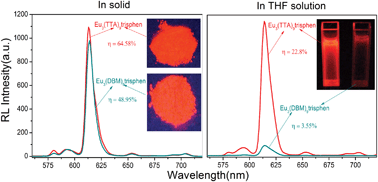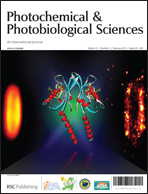Two novel trinuclear europium complexes based on trisphen(1,3,5-tris{4-((1,10-phenanthroline-[5,6-d]imidazol-2yl)phenoxy)methyl}-2,4,6-trimethyl-benzene) as a second ligand were designed, synthesized, and characterized by FT-IR, 1H NMR, UV-visible, photoluminescence (PL) spectroscopy, elemental analysis (EA) and ESI-MS. The geometries of these two trinuclear europium complexes were predicted using the Sparkle/PM3 model and suggested a chemical environment of very low symmetry around the lanthanide ions (C1), which is in agreement with the luminescent spectra. CV analysis demonstrated that the trinuclear complexes possessed excellent electro-injection abilities. The effects of two additional Eu3+ lumophors in these trinuclear europium complexes on their photoluminescent properties were investigated in detail. The results indicated that these trinuclear europium complexes exhibited highly luminescent quantum efficiencies and experimental intensity parameters in the solid state. Especially, due to the contribution of the two additional Eu3+ lumophors in the trinuclear europium complexes, the quantum efficiency of the trinuclear complex Eu3(TTA)9trisphen was higher (ca. 34%) than the mononuclear europium complex Eu(TTA)3imidazophen.

You have access to this article
 Please wait while we load your content...
Something went wrong. Try again?
Please wait while we load your content...
Something went wrong. Try again?


 Please wait while we load your content...
Please wait while we load your content...